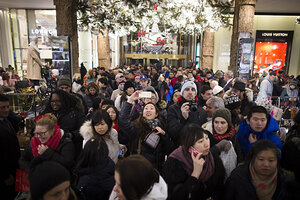Retail sales surprise in November
Retail sales November posted their biggest gain in five months as US consumers ramped up spending on cars, appliances, furniture, and online purchases. The rise in retail sales bodes well for the rest of the holiday shopping season.

A shopper takes a selfie as crowds pour into the Macy's Herald Square flagship store in New York on Thanksgiving. Retail sales in November posted the biggest gain in five months.
John Minchillo/AP/File
Washington
U.S. consumers ramped up spending in November on cars, appliances and furniture and made more purchases online, signaling growing confidence in the economy at the start of the holiday shopping season.
The Commerce Department said Thursday that retail sales rose 0.7 percent, the biggest gain in five months. October's figure was also revised higher to 0.6 percent.
Two straight months of healthy sales suggest steady hiring is encouraging Americans to spend more this holiday season, particularly on big-ticket items. That could give a critical boost to the economic growth.
Thursday's report "suggests that the holiday shopping season began on a strong note," Paul Dales, an economist at Capital Economics, said in a note to clients.
The report also shows that consumers purchased more at home on their computers last month — and less at traditional stores. Those trends could explain why many retail chains estimated disappointing sales over the Thanksgiving holiday weekend, one of the most critical for those businesses.
Auto sales jumped 1.8 percent, furniture purchases rose 1.2 percent and sales at electronics and appliances stores rose 1.1 percent. Excluding the volatile categories of autos, gas and building materials, sales rose a solid 0.5 percent in November.
Americans also are shifting more spending to online and catalog retailers. Online and catalog sales rose 2.2 percent last month, the most in nearly 18 months.
Sales were weak at some retail chains. Clothing and grocery stores reported lower sales last month. And gains at department stores, health care and sporting goods stores were all tepid. Nonetheless, Americans are spending more, which could give a much-needed boost to the economy in the final three months of the year. Consumer spending rose only 1.4 percent in the July-September quarter, the weakest gain in nearly four years.
But economists are becoming more optimistic about the current quarter. Dales expects consumer spending will rise at about a 3 percent annual pace, roughly double the third quarter's rate. He forecasts that overall growth will be 2 percent at an annual rate.
That would be down from the third quarter's solid growth rate of 3.6 percent. But nearly half that growth came from inventory restocking, as companies added more goods to their warehouses and store shelves. More spending would ensure that businesses aren't caught with unwanted supplies and keep the economy expanding.
Consumer spending drives roughly 70 percent of growth.
Hiring has been solid since the summer, giving more Americans paychecks to spend. Employers added 203,000 jobs in October and the unemployment rate fell to a five-year low of 7 percent. Wages even picked up a bit and have risen 2 percent over the past year, outpacing inflation.

